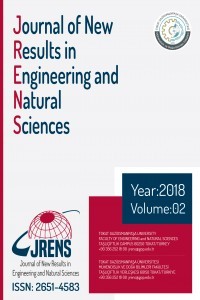Santrifuj Pompa için Eddy Akımlı Manyetik Kavramanın Sonlu Elemanlar Analizi
Eddy akımı, temassız olarak güç ve hareket aktarmak için kullanılabilmektedir. Bunun için radyal akılı döner bir manyetik rotor içerisinde yer alan demirsiz ve iletken pompa rotorunda bir eddy akımı indüklenir ve bu akımın etkisi ile pompa rotorunda oluşan manyetik alan ve Lorentz kuvveti rotora temassız güç aktarımı sağlar. Manyetik rotor ile pompa rotoru arasındaki hava aralığı, kutup sayısı, mıknatıs kalınlığı, pompa rotorunun et kalınlığı, malzemenin iletkenliği ve manyetik rotorun hızı manyetik kavramanın verimine ve performansına etki etmektedir. Bu etkiler sonlu elemalar yöntemi ile analiz yapan Ansys Maxwell programında çözülmüştür. Bu çalışmada 6 kutuplu, 8 mm kalınlıkta N52 Neodymium mıknatıslı manyetik rotorun 4500 rpm hız ile dönmesi durumunda 3 mm hava aralığında et kalınlığı 5mm olan alüminyum pompa rotorunda 3951 rpm hız ve 0.5 Nm tork üretilmiştir. Bu tasarımda manyetik rotora giren mekanik güç %87,8 oranında pompaya aktarıldığı hesaplanmıştır. 7 mm kalınlıkta bakır rotor kullanıldığında ise verim %92.3 olarak çözülmüştür. Alüminyum rotorlu tasarım imalat kolaylığı ve maliyet açısından tercih edilmiştir.
Anahtar Kelimeler:
Manyetik kavrama, eddy akımlı kavrama, manyetik kavramalı pompa
Finite Element Analysis of Eddy Current Magnetic Coupling for Centrifigual Pump
Eddy currents can be used to transfer power and motion without contact. For this, an eddy current is induced
in the non-ferrous and conductive pump rotor in a radial flux rotary magnetic rotor, and the magnetic field
and Lorentz force generated in the pump rotor with the effect of this current provide non-contact power
transfer to the rotor. The air gap between the magnetic rotor and the pump rotor, the number of poles, the
magnet thickness, the wall thickness of the pump rotor, the conductivity of the material and the speed of
the magnetic rotor affect the efficiency and performance of the magnetic coupling. These effects are solved
in Ansys Maxwell program, which analyzes with finite element method. In this study, 3951 rpm speed and
0.5 Nm torque were generated in an aluminum pump rotor with a wall thickness of 5 mm from a 3 mm air
gap when a 6-pole, 8 mm-thick N52 Neodymium magnets when magnetic rotor rotates at 4500 rpm. In this
design, it has been calculated that 87.8% of the input mechanical power the magnetic rotor is transferred to
the pump. The efficiency was 92.3% when a 7 mm thick copper rotor was used. Aluminum rotor design
has been preferred for ease of manufacture and low cost
Keywords:
Magnetic coupling, eddy current coupling, magnetic coupled pump,
___
- [1] Wang, J., Lin, H., Fang, S. and Huang, Y. (2014) A general analytical model of permanent magnet eddy current couplings, IEEE Transaction on Magnetics, 50(1), 1–9.
- [2] Yang, X., Liu,Y. and Wang,L. (2019) Nonlinear Modeling of Transmission Performance for Permanent Magnet Eddy Current Coupler, Hindawi Mathematical Problems in Engineering, 2019:(1-15).
- [3] Wang J, and Zhu,J. (2018) A Simple Method for Performance Prediction of Permanent Magnet Eddy Current Couplings Using a New Magnetic Equivalent Circuit Model, IEEE Transactions On Industrial Electronics, Vol. 65(3):2487-2495.
- [4] Fontchastagner,J., Lubin,T, Mezani,S. and Takorabet, N (2018) Design optimization of an axial-field eddy-current magnetic coupling based on magnetothermal analytical model, Open Physics, 16:21–26, 2018.
- [5] Li,Z., Wang, D., Zheng, and Yu,. L, (2017). Analytical modeling and analysis of magnetic field and torque for novel axial flux eddy current couplers with PM excitation Information Science and Engineering, Northeastern University, Shenyang 7(105303):1-13.
- [6] Lubin, T., Fontchastagner, J., Mezani,S., and Rezzoug, A. (2016), Comparison of Transient Performances for Synchronous and Eddy-current Torque Couplers, XXIIth International Conference on Electrical Machines - ICEM 2016, Lausanne, Switzerland.
- [7] Lubin, T., and Rezzoug,A. (2015). Steady-state and transient performance of axial-field eddy-current coupling, IEEE Transaction on Industrial Electronics, 62(4), 2287–2296.
- [8] Hamideh K. Razavi and Michael U. Lampérth (2006). Eddy-Current Coupling With Slotted Conductor Disk, IEEE Transactions on Magnetics, 42(3):405-410.
- [9] Canova and Vusini, B. (2005). Analytical modeling of rotating eddy-current couplers, IEEE Transaction on Magnetics, 41(1), 24–35.
- [10] Fenercioğlu, A., Avşar, Y. (2020). Finite Element Analysis of Eddy Current Actuator for Linear Motion, IWED 2020, Moskova, Rusya
- Yayın Aralığı: Yılda 2 Sayı
- Başlangıç: 2013
- Yayıncı: Tokat Gaziosmanpaşa Üniversitesi
